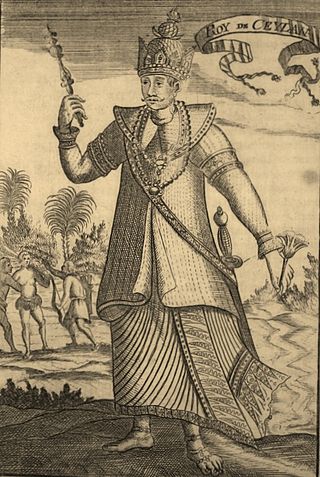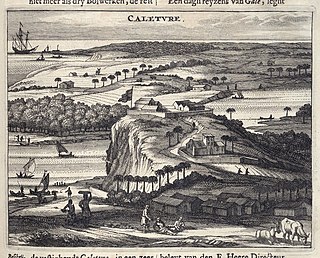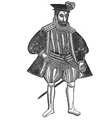
Dominicus Corea also known as Domingos Corea and Edirille Rala, was the son of Don Jeronimo Corea and Anna Corea. Don Jeronimo Corea was also known as Mudaliyar Vikramasinha, Commander-in-Chief of King Mayadunne's army. Jeronimo Corea was executed by King Mayadunne's son, Rajasinghe. Dominicus Corea was born in Colombo in 1565. At that time, the Portuguese had colonised Ceylon, and his parents converted to Catholicism.

The Kingdom of Kandy was a monarchy on the island of Sri Lanka, located in the central and eastern portion of the island. It was founded in the late 15th century and endured until the early 19th century.

Vimaladharmasūriya I was a king of Kandy from 1590 to 1604. His reputation was built when he successfully repulsed two major Portuguese offensives on Kandy, the Battle of Danture in 1594 and the Battle of Balana in 1602, in both of which the Portuguese were humiliatingly defeated.

The Kingdom of Sitawaka was a kingdom located in south-central Sri Lanka. It emerged from the division of the Kingdom of Kotte following the Spoiling of Vijayabahu in 1521. Over the course of the next seventy years it came to dominate much of the island. Sitawaka also offered fierce resistance to the Portuguese, who had arrived on the island in 1505. Despite its military successes, Sitawaka remained unstable, having to contend with repeated uprisings in its restive Kandyan territories, as well as a wide-ranging and often devastating conflict with the Portuguese. Sitawaka disintegrated soon after the death of its last king Rajasimha I in 1593.
The Governor of Ceylon can refer to historical vice-regal representatives of three colonial powers:

Lascarins is a term used in Sri Lanka to identify indigenous soldiers who fought for the Portuguese during the Portuguese era (1505–1658) and continued to serve as colonial soldiers until the 1930s. The lascarins played a crucial role not only in the colonial armies, but also in the success of the campaigns of the local kingdoms.

The Kingdom of Kotte, named after its capital, Kotte, was a Sinhalese kingdom that flourished in Sri Lanka during the 15th century.

Dom Jerónimo de Azevedo was a Portuguese fidalgo, Governor (captain-general) of Portuguese Ceylon and viceroy of Portuguese India. He proclaimed in Colombo, in 1597, the King of Portugal, Philip I, as the legitimate heir to the throne of Kotte, thus substantiating the Portuguese claims of sovereignty over the island of Ceylon.

Kusumāsana Devi, also known as Dona Catherina, was ruling Queen of Kandy in 1581. She was deposed, but queen consort of Kandy by marriage to Vimaladharmasuriya I of Kandy from 1594 to 1604.
Diogo de Melo Coutinho was the second and eleventh Captain-major of Portuguese Ceylon. Coutinho was first appointed in 1552 under John III of Portugal, he was Captain-major until 1552. His second term lasted from 1570-1572. He was succeeded by Duarte de Eça and António de Noronha respectively.
João de Correia de Brito was the 15th Captain-major of Portuguese Ceylon. Brito was appointed in 1583 under Philip I of Portugal, he was Captain-major until 1590. He was succeeded by Simão de Brito.
Pedro Homem Pereira was the 17th and last Captain-major of Portuguese Ceylon. Pereira was appointed in 1591 under Philip I of Portugal, he was Captain-major until 1594. The office of Captain-major was abolished and he was succeeded by Pedro Lopes de Sousa as Governor of Portuguese Ceylon.

Pedro Lopes de Sousa was the 1st Governor of Portuguese Ceylon. The office of Captain-major was abolished in 1594 and de Sousa was appointed in the same year under Philip I of Portugal. He died that year in the Campaign of Danture.
The Danture campaign comprised a series of encounters between the Portuguese and the Kingdom of Kandy in 1594, part of the Sinhalese–Portuguese War. It is considered a turning point in the indigenous resistance to Portuguese expansion. For the first time in Sri Lanka a Portuguese army was essentially annihilated, when they were on the verge of the total conquest of the island. A 20,000-strong Portuguese army, led by Governor Pedro Lopes de Sousa, invaded Kandy on 5 July 1594. After three months, severely depleted by guerilla warfare and mass desertions, what remained of the Portuguese army was annihilated at Danture by the Kandyans under King Vimaladharmasuriya. With this victory, the Kingdom of Kandy emerged as a major military power; it was to retain its independence, against Portuguese, Dutch, and British armies, until 1815.

Sinhalese–Portuguese conflicts refers to the series of armed engagements that took place from 1518 to 1658 in Sri Lanka between the native Sinhalese kingdoms and the Portuguese Empire. It spanned from the Transitional to the Kandyan periods of Sri Lankan history. A combination of political and military moves gained the Portuguese control over most of the island, but their invasion of the final independent kingdom was a disaster, leading to a stalemate in the wider war and a truce from 1621. In 1638 the war restarted when the Dutch East India Company intervened in the conflict, initially as an ally of the Sinhalese against the Portuguese, but later as an enemy of both sides. The war concluded in 1658, with the Dutch in control of about half the island, the Kingdom of Kandy the other half, and the Portuguese expelled.

Kalutara fort was built by the Portuguese in 1622. It was located in Kalutara, Sri Lanka.

Ruwanwella fort, was initially a fortified base camp erected by the Portuguese in 1590s at Ruwanwella, Kegalle. It was captured by Dutch in 1665, who constructed a wooden fort (Ruanelle) but abandoned it within a few years. In 1817 the British built a stone fort on the site with two bastions.











